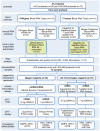Comparison of whole blood RNA preservation tubes and novel generation RNA extraction kits for analysis of mRNA and MiRNA profiles
- PMID: 25469788
- PMCID: PMC4254602
- DOI: 10.1371/journal.pone.0113298
Comparison of whole blood RNA preservation tubes and novel generation RNA extraction kits for analysis of mRNA and MiRNA profiles
Abstract
Background: Whole blood expression profiling is frequently performed using PAXgene (Qiagen) or Tempus (Life Technologies) tubes. Here, we compare 6 novel generation RNA isolation protocols with respect to RNA quantity, quality and recovery of mRNA and miRNA.
Methods: 3 PAXgene and 3 Tempus Tubes were collected from participants of the LIFE study with (n = 12) and without (n = 35) acute myocardial infarction (AMI). RNA was extracted with 4 manual protocols from Qiagen (PAXgene Blood miRNA Kit), Life Technologies (MagMAX for Stabilized Blood Tubes RNA Isolation Kit), and Norgen Biotek (Norgen Preserved Blood RNA Purification Kit I and Kit II), and 2 (semi-)automated protocols on the QIAsymphony (Qiagen) and MagMAX Express-96 Magnetic Particle Processor (Life Technologies). RNA quantity and quality was determined. For biological validation, RNA from 12 representative probands, extracted with all 6 kits (n = 72), was reverse transcribed and mRNAs (matrix metalloproteinase 9, arginase 1) and miRNAs (miR133a, miR1), shown to be altered by AMI, were analyzed.
Results: RNA yields were highest using the Norgen Kit I with Tempus Tubes and lowest using the Norgen Kit II with PAXgene. The disease status was the second major determinant of RNA yields (LIFE-AMI 11.2 vs. LIFE 6.7 µg, p<0.001) followed by the choice of blood collection tube. (Semi-)automation reduced overall RNA extraction time but did not generally reduce hands-on-time. RNA yields and quality were comparable between manual and automated extraction protocols. mRNA expression was not affected by collection tubes and RNA extraction kits but by RT/qPCR reagents with exception of the Norgen Kit II, which led to mRNA depletion. For miRNAs, expression differences related to collection tubes (miR30b), RNA isolation (Norgen Kit II), and RT/qRT reagents (miR133a) were observed.
Conclusion: We demonstrate that novel generation RNA isolation kits significantly differed with respect to RNA recovery and affected miRNA but not mRNA expression profiles.
Conflict of interest statement
Figures




Similar articles
-
Simultaneous extraction of mRNA and microRNA from whole blood stabilized in tempus tubes.BMC Res Notes. 2019 Jan 18;12(1):39. doi: 10.1186/s13104-019-4087-5. BMC Res Notes. 2019. PMID: 30658701 Free PMC article.
-
Comparison of blood RNA isolation methods from samples stabilized in Tempus tubes and stored at a large human biobank.BMC Res Notes. 2016 Sep 1;9(1):430. doi: 10.1186/s13104-016-2224-y. BMC Res Notes. 2016. PMID: 27587079 Free PMC article.
-
Preanalytical robustness of blood collection tubes with RNA stabilizers.Clin Chem Lab Med. 2019 Sep 25;57(10):1522-1529. doi: 10.1515/cclm-2019-0170. Clin Chem Lab Med. 2019. PMID: 31112504
-
Gene expression differences between PAXgene and Tempus blood RNA tubes are highly reproducible between independent samples and biobanks.BMC Res Notes. 2017 Mar 23;10(1):136. doi: 10.1186/s13104-017-2455-6. BMC Res Notes. 2017. PMID: 28335817 Free PMC article.
-
MicroRNA isolation and stability in stored RNA samples.Biochem Biophys Res Commun. 2009 Dec 4;390(1):1-4. doi: 10.1016/j.bbrc.2009.09.061. Epub 2009 Sep 19. Biochem Biophys Res Commun. 2009. PMID: 19769940 Review.
Cited by
-
Toward reliable biomarker signatures in the age of liquid biopsies - how to standardize the small RNA-Seq workflow.Nucleic Acids Res. 2016 Jul 27;44(13):5995-6018. doi: 10.1093/nar/gkw545. Epub 2016 Jun 17. Nucleic Acids Res. 2016. PMID: 27317696 Free PMC article.
-
Characteristics of RNA Stabilizer RNApro for Peripheral Blood Collection.Diagnostics (Basel). 2024 May 7;14(10):971. doi: 10.3390/diagnostics14100971. Diagnostics (Basel). 2024. PMID: 38786269 Free PMC article.
-
A single workflow for multi-species blood transcriptomics.BMC Genomics. 2024 Mar 16;25(1):282. doi: 10.1186/s12864-024-10208-2. BMC Genomics. 2024. PMID: 38493105 Free PMC article.
-
Expression of circulating miR-486 and miR-150 in patients with acute myocardial infarction.BMC Cardiovasc Disord. 2015 Jun 16;15:51. doi: 10.1186/s12872-015-0042-0. BMC Cardiovasc Disord. 2015. PMID: 26077801 Free PMC article.
-
Identification of an optimal method for extracting RNA from human skin biopsy, using domestic pig as a model system.Sci Rep. 2019 Dec 27;9(1):20111. doi: 10.1038/s41598-019-56579-5. Sci Rep. 2019. PMID: 31882887 Free PMC article.
References
-
- Rainen L, Oelmueller U, Jurgensen S, Wyrich R, Ballas C, et al. (2002) Stabilization of mRNA expression in whole blood samples. Clin Chem 48:1883–1890. - PubMed
-
- Baechler EC, Batliwalla FM, Karypis G, Gaffney PM, Moser K, et al. (2004) Expression levels for many genes in human peripheral blood cells are highly sensitive to ex vivo incubation. Genes and Immunity 5:347–353. - PubMed
Publication types
MeSH terms
Substances
LinkOut - more resources
Full Text Sources
Other Literature Sources
Research Materials
Miscellaneous

